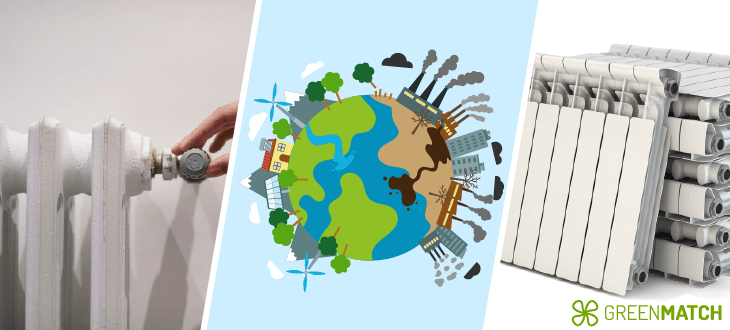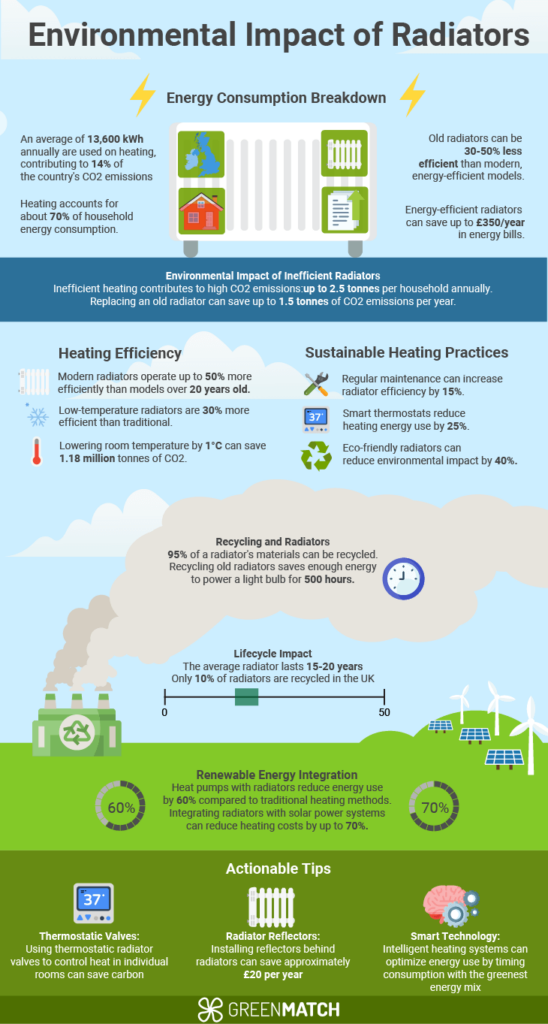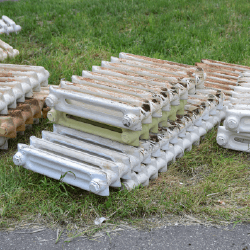- GreenMatch
- Blog
- Are Radiators Bad For The Environment? Statistics And Facts
Are Radiators Bad For The Environment?


In the face of climate change, every aspect of our daily lives is scrutinised for its environmental impact, including how we heat our homes. Traditional radiators, often powered by fossil fuels, are a significant source of greenhouse gas emissions, contributing to the urgent problem of global warming.
With heating being a significant energy expense in UK homes, the environmental and economic stakes are high. Heating accounts for about 53% of a household's energy bill.
This article will explore the environmental footprint of traditional radiators, which play a considerable role in household energy consumption. By considering energy usage, emissions, and material sustainability, homeowners can make informed decisions that benefit the environment and their health.
What Do We Mean By Radiators Exactly
Radiators transfer thermal energy from one medium to another for heating or cooling. In this context, we are primarily concerned with radiators used for heating spaces, such as those found in residential, commercial, and industrial buildings.
These can be powered by various energy sources, including electricity, natural gas, oil, or steam, and they operate by circulating a heated fluid (usually water or steam) through a series of pipes and panels that radiate heat into the surrounding area.
Moreover, they are made from different materials, including copper, brass, and, increasingly, aluminium, due to their lighter weight and cost-effectiveness.
Production and Consumption Worldwide
Radiators remain a vital component of heating systems worldwide, with a steady market growth driven by the demand for energy-efficient and sustainable heating solutions.
Radiators can also impact indoor air quality and health. Dust and debris accumulation behind radiators can pose health hazards, particularly for individuals with respiratory issues. Ensuring clean and well-maintained radiators is essential for environmental and health reasons.
The global central heating radiator market is expected to grow considerably between 2023 and 2030. This growth suggests an increasing demand for heating solutions, which could have environmental implications depending on the types chosen.
On the other hand, eco-friendly radiators, including energy-efficient and electric models, offer significant benefits in terms of reduced energy consumption, lower emissions, and the use of recyclable materials.
| Feature | Traditional Radiators | Eco-Friendly Radiators |
|---|---|---|
| Energy Efficiency | Lower | Higher |
| Emissions | Higher | Lower |
| Materials | Non-recyclable | Recyclable (steel, aluminium) |
| Lifespan | Shorter | Up to 20 years or more |
| Cost Over Time | Higher energy bills | Lower energy bills |
The global heating radiator market was valued at approximately 3.55 billion GBP in 2021 and is expected to grow at a compound annual growth rate (CAGR) of 4.5% from 2022 to 2030.
Europe holds the largest market share, with a focus on energy-efficient heating solutions.
Environmental Impact of Traditional Radiators
Traditional radiators can have a considerable environmental footprint depending on their energy source. If powered by fossil fuels, such as natural gas or oil, they contribute to greenhouse gas emissions. These fuels' production, transportation, and combustion release carbon dioxide and other pollutants into the atmosphere, exacerbating climate change and air quality issues.
According to EIA, space heating is the top energy-consuming end-use in homes, accounting for 42% of residential energy consumption. Another source confirms that heat energy-related carbon dioxide emissions from space heating globally account for 40%.
| Material Type | Energy Consumption (kWh) | CO2 Emissions (kg CO2) |
|---|---|---|
| Steel | High | High |
| Aluminum | Medium | Medium |
| Copper | High | High |

What Is So Bad About Radiators For The Environment?
Traditional radiators, especially those powered by fossil fuels, are a significant source of greenhouse gas emissions. These emissions contribute to climate change, making the heating method less sustainable.
The carbon footprint escalates if the energy comes from non-renewable sources like coal, oil, or natural gas. Additionally, older radiator systems are often less efficient, leading to wasted energy and higher emissions.
Additionally, the production and disposal of radiators involve non-renewable materials, further exacerbating their environmental impact. Furthermore, they can aggravate indoor air pollution by circulating dust particles, VOCs (Volatile Organic Components), and allergens, harming respiratory health.
The production process of radiators also has environmental implications involving the extraction, manufacturing, and transportation of materials. These processes consume energy and resources, contributing further to their environmental impact.
What Is The Impact Of Radiators?
Total Impact per Year
Radiators contribute to a substantial portion of residential energy consumption, with traditional systems being less energy-efficient and more environmentally damaging.
In the UK alone, heating contributes to about 37% of the country's total carbon emissions, with a substantial portion coming from residential heating systems, including radiators. In the US, residential heating and cooling contribute to 38% of greenhouse gas emissions from housing.
Globally, the exact total impact per year can vary widely depending on the number of radiators used, their efficiency, and their power source. However, the cumulative environmental impact is significant in countries with a high reliance on radiators for heating.
Impact per Day
Daily, the operation of inefficient radiators leads to unnecessary energy consumption and increased carbon emissions. Also, the environmental impact of radiators varies significantly depending on the outside temperature, the efficiency of the system, and the energy source. The daily impact is notably higher during colder months due to increased usage.
Impact per usage
Each time a radiator system is activated, it consumes energy. The system's efficiency and the type of energy source determine the impact per usage. For instance, radiators powered by renewable energy sources such as solar thermal systems have a lower environmental impact per use than those relying on fossil fuels.
Top Contributors to Radiator Environmental Impact
Countries with colder climates, such as the UK, Canada, and Russia, have higher dependencies on heating systems, including radiators, contributing more to the environmental impact. With its vast spaces requiring heating, the industrial sector also significantly affects the overall environmental footprint.
The following table lists the top regions and industries that contribute to the environmental impact of radiators:
| Region | Industry | Contribution to Radiator Impact |
|---|---|---|
| Europe | Heating Systems | High demand for energy-efficient heating |
| North America | Renovation | Replacement of inefficient heating systems |
| Asia-Pacific | Urbanisation | Surge in demand for heating solutions |
| Automotive | Vehicle Production | Shift from copper/brass to aluminium radiator |
Radiators in the Largest Economies
While effective in heating, traditional radiators can be responsible for significant greenhouse gas emissions, particularly if fossil fuels power them.
Over time, the technology evolved, and by the 19th century, cast iron radiator systems became popular in America, eventually spreading to Europe. Traditional radiators are still widely used globally, including in the largest economies.
Here is the list of the top five countries using traditional radiators and discusses the environmental implications of their use.
Top 5 Countries Using Traditional Radiators
| Country | Impact on Environment | Use of Eco-Friendly Alternatives | Economic Impact |
|---|---|---|---|
| United States | High emissions from fossil fuels | Increasing adoption of eco-friendly radiators | The market is estimated at £1.58 Billion |
| China | Significant greenhouse gas emissions | Growth in the eco-friendly radiator market | Market projected to reach £1.82 Billion by 2030 |
| Germany | Emissions contributing to climate change | Shift towards energy-efficient radiators | Market to grow at 3.1% CAGR |
| Japan | Dependency on fossil fuels for heating | Eco-friendly radiators are gaining popularity | Market forecast to grow at 2.4% CAGR |
| United Kingdom | Traditional radiators prevalent in homes | Rising interest in designer and eco-friendly radiators | Adoption of steel radiators since the 1950s |
The environmental benefits of using eco-friendly radiators include reduced energy usage, fewer emissions, and the use of recyclable materials like steel and aluminium. These radiators are designed to last longer, reducing the need for replacements and minimising waste.
Are Radiators Biodegradable?
Radiators are not typically biodegradable due to the materials they are made from, such as metal and plastic. This is because they are normally made from steel, aluminium, or cast iron, which do not break down organically in the environment.
However, many modern radiators are designed with sustainability in mind. For instance, electric radiators can be manufactured from recycled steel and aluminium. At the end of their life, they are 100% recyclable, meaning they can be repurposed without ending up in landfills.
Are Radiators Toxic?
While not inherently toxic, they can contribute to poor indoor air quality if not cleaned regularly due to dust accumulation and other allergens. The primary toxic risk associated with radiator heating systems is carbon monoxide poisoning, which is related to the boiler rather than the radiators.
It is crucial to have a carbon monoxide detector in homes and to ensure boilers are regularly serviced by a Gas Safe Registered engineer to prevent CO poisoning.
On the other hand, electric radiators are considered safe and do not present the same risks as gas-powered systems. They do not involve combustion, so there is no risk of gas leaks or carbon monoxide poisoning.
Are Radiators Sustainable?
It can be sustainable when it is energy-efficient, made from or uses sustainable materials, recyclable, compatible with renewable energy sources, and enhanced with smart technologies. In addition, since they do not decompose, their sustainability is often assessed in production, operation, and end-of-life disposal.
The industry is moving towards more sustainable practices, focusing on energy efficiency and reduced environmental impact.
For example, according to The Radiator Centre, the Livingstone range of radiators is created from marble powder, a by-product of the marble cutting process. This material is mixed with water and other binding agents, placed into moulds by hand, and left to dry naturally. The marble can be crushed and recycled at the end of the radiator's life cycle.
Furthermore, the modern ones are designed with energy efficiency in mind. Features like low-H2O technology and compatibility with renewable energy sources, such as ground and air heat pumps, enhance their sustainability. These radiators require less energy to achieve the same level of warmth, reducing carbon emissions and energy bills.
Can Radiators be Recycled?

Radiators are indeed recyclable, and their recycling is beneficial for the environment. Most radiators are manufactured from recycled materials like steel and aluminium and are 100% recyclable at the end of their life. This means the materials can be reused, reducing the need for new resources and minimising waste.
The automotive and heating industries significantly contribute to the supply of recyclability. With the growth of these industries, especially in regions like North America, Europe, and Asia-Pacific, the availability of scrap radiators for recycling is on the rise.
| Material | Recyclability | Environmental Benefit |
|---|---|---|
| Aluminum | High | Energy conservation, reduced mining |
| Copper | High | Energy conservation, reduced mining |
| Iron | Moderate | Energy conservation, reduced landfill use |
Radiator Recycling Process
Radiators, whether from vehicles or home heating systems, are primarily composed of metals such as aluminium and copper, highly recyclable materials. The recycling process typically involves the following steps:
What Are Alternatives to Radiators?
While radiators have their place in home heating, several alternatives offer improved efficiency, aesthetics, and environmental benefits. Whether you're building a new home or looking to upgrade your heating system, it's worth considering these alternatives. Not only can they provide comfortable, efficient heating, but they can also contribute to a more sustainable future.
Let's explore some of the most promising alternatives to traditional radiators.
Alternatives to Consider
To illustrate the benefits of these alternatives, the table below provides a comparative overview of the options based on key factors—this guide of traditional or eco-friendly radiators, which offer several environmental benefits.
| Heating Alternative | Energy Efficiency | Environmental Impact | Space Saving | Installation Cost | Longevity |
|---|---|---|---|---|---|
| Traditional Radiators | Medium | Medium | No | Low | High |
| ThermaSkirt | High | Low | Yes | Medium | Moderate |
| Underfloor Heating | High | Low | Yes | High | High |
| Infrared Panels | High | Low | Yes | Medium | Moderate |
| Convection Heaters | High | Medium | Yes | Low | Moderate |
| Radiant Ceiling Panels | High | Low | Yes | Medium | High |
| Air Source Heat Pumps | High | Very Low | N/A | High | High |
| Heat Pumps | High | High | Moderate | Moderate | High |
Is Better Than Its Alternatives?
The answer depends on various factors, including your heating needs, budget, and environmental considerations. Traditional radiators are simple, cost-effective, and suitable for many homes. However, they can be less efficient, especially in spaces with high ceilings or lots of glass, and they take up valuable wall space.
Alternatives like ThermaSkirt, underfloor heating, and infrared panels offer more efficient heating, can save space, and have a lower environmental impact. For instance, underfloor heating provides a more even heat distribution and can be more energy-efficient, especially when paired with renewable energy sources. Air source heat pumps are another eco-friendly option, efficiently heating your home while reducing carbon emissions.
Statistics, Facts, and Figures About Radiators
The global heating radiator market is evolving, with a strong emphasis on energy efficiency, technological advancements, and environmental sustainability. Here is a list of environmental impacts highlighting key statistics and trends according to different sources like Statista, ONS
The global heating radiator market was valued at approximately £3.37 billion in 2021 and is projected to grow at a compound annual growth rate (CAGR) of 4.5% from 2022 to 2030, reaching around £4.98 billion by the end of the forecast period.
Hydronic radiators, which use hot water or steam, are the most common and account for over 61.5% of the market share.
Fossil fuel-powered radiators emit carbon dioxide (CO2), methane (CH4), and other greenhouse gases contributing to global warming.
Electric radiators, in particular, are gaining popularity due to their efficiency in maintaining precise temperatures and lower operating costs than hydronic radiators.
Over 90% of homes in the UK use central heating radiator systems, indicating the efficiency and popularity of this heating method.
China is projected to account for nearly 75% of car radiator sales in the East Asian region by the end of 2033.
Prominent global heating radiator market companies include Henrad, Stelrad, Runtal, Vasco Group, Zehnder Group, and Purmo Group.
In 2021, the United Kingdom saw a sales volume of 301,035 units of electric radiators and heaters, marking a 5% decrease compared to the previous year.
Eco-friendly radiators use less energy and are made from recyclable materials like steel and aluminium, which are sustainable and reduce the carbon footprint.
Energy-efficient radiators like K3 models have larger surface areas, allowing quicker or more effective heating at lower temperatures.
- Radiators primarily use convection rather than radiation to heat spaces.
- The Romans had the first documented central heating system, known as the hypocaust, around 100 BC.
- The modern radiator was invented by Franz San-Galli in the 1850s.
- The UK sees a surge in gas use for central heating around the 1st of October each year
- Despite the name, radiators primarily use convection rather than radiation to heat a room
FAQ about Radiators
Yes, a malfunctioning radiator can have environmental consequences. For instance, if the toxic radiator fluid leaks due to a malfunction, it can harm wildlife and contaminate soil and water supplies. Proper maintenance and immediate repair of radiator issues are essential to prevent such environmental hazards.
Home heating and radiators account for significant energy use and greenhouse gas emissions. Gas boilers that heat water for radiators are less efficient than other heating methods. To reduce environmental impact, consider lowering the water heater temperature, insulating pipes, fixing leaks, and using energy-efficient appliances. When replacing a radiator, look for Energy Star-certified options and consider recycling the old appliance.
Recycling radiators benefits the environment by reducing waste, conserving energy, and supporting the economy. Recyclers pay for scrap radiators, and the materials recovered can be used to manufacture new products, reducing the need for raw material extraction and processing.
Radiators are typically made from metals like aluminium, copper, or brass, which are recyclable. The shift towards aluminium in car radiators has increased due to its lower density and cost than copper, despite copper’s superior thermal conductivity.
The ideal location for a radiator is near areas of heat loss, such as under a window, to allow the cold air entering through the window to mix with the warm air from the radiator, promoting efficient circulation.
However, some argue that placing radiators away from colder areas is more cost-effective. Ultimately, the decision should be based on your home’s specific layout and heating needs.

Inemesit is a seasoned content writer with 9 years of experience in B2B and B2C. Her expertise in sustainability and green technologies guides readers towards eco-friendly choices, significantly contributing to the field of renewable energy and environmental sustainability.
We strive to connect our customers with the right product and supplier. Would you like to be part of GreenMatch?

